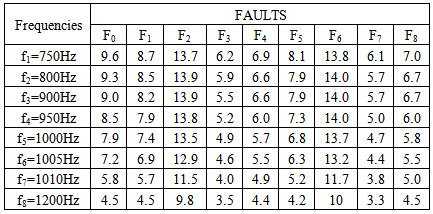-
Paper Information
- Paper Submission
-
Journal Information
- About This Journal
- Editorial Board
- Current Issue
- Archive
- Author Guidelines
- Contact Us
Electrical and Electronic Engineering
p-ISSN: 2162-9455 e-ISSN: 2162-8459
2014; 4(2): 25-30
doi:10.5923/j.eee.20140402.01
Optimized Multi Frequency Approach to Analog Fault Diagnosis Using Monte Carlo Analysis
S. P. Venu Madhava Rao, K. Siva Sundari
Department of Electronics & Communication Engineering, Sreenidhi Institute of Science & Technology, Hyderabad, 501301, India
Correspondence to: S. P. Venu Madhava Rao, Department of Electronics & Communication Engineering, Sreenidhi Institute of Science & Technology, Hyderabad, 501301, India.
| Email: |  |
Copyright © 2014 Scientific & Academic Publishing. All Rights Reserved.
The proliferation of large analog circuits and systems of ever increasing complexity has stirred great interest in different methods for fault diagnosis of analog circuits. In Analog circuit fault diagnosis, the measurements of the circuit are used in the construction of the fault dictionary. The fault dictionary represents readings of the circuit under different fault conditions and one nominal condition at different test frequencies. Based on the fault dictionary readings, sets of faults which have almost the same fault signature are identified and are called ambiguity sets. In this paper the multi frequency approach to fault diagnosis has been optimized using the concept of sub-ambiguity tables. It has been shown here that the number of test frequencies required to diagnose faults has been significantly reduced and also the simulation time taken has been reduced.
Keywords: Integer Coded Fault Dictionary, Sub Ambiguity Table, Monte Carlo Analysis, Multi Frequency Approach
Cite this paper: S. P. Venu Madhava Rao, K. Siva Sundari, Optimized Multi Frequency Approach to Analog Fault Diagnosis Using Monte Carlo Analysis, Electrical and Electronic Engineering, Vol. 4 No. 2, 2014, pp. 25-30. doi: 10.5923/j.eee.20140402.01.
Article Outline
1. Introduction
- Analog electronic circuit fault diagnosis has gained wide spread attention in the area of atomised testing with the help of computers. Advances in the System on Chip technology have resulted in increased importance of the analog circuitry thus moving into the mainstream IC technology. The advances made in deep sub- micron technology and the co- existence of analog and digital circuits has increased the complexity of the IC’s. This has made fault diagnosis a very challenging task, particularly analog fault diagnosis.There are two important fault diagnosis techniques which are based on the stage at which the simulation is carried out to test the system: Simulation After Test (SAT) and Simulation Before Test (SBT) approach. In SAT approach the simulation is carried out at the time of testing. This is done to identify the Network parameters, by measuring the voltage and current. The faulty elements are then identified by determining those components which fall outside the design tolerance range. The SBT approach places emphasis on building the fault dictionary, in which the nominal behaviour of the circuit in DC, Time domain or Frequency domain is stimulated. The responses of the circuit for various faults are stored in the fault dictionary. Fault simulation plays a very important role in the construction of the fault dictionaries. The factors that decide the effectiveness of this technique are the proper choice of stimulus, selection of test measurement optimization and fault isolation. The number of test measurements is chosen such that all or maximum number of faults are diagnosed. This criterion may sometimes drastically increase the size of the fault dictionary. Optimisation is done to remove the measurements which are redundant or that do not help in fault isolation. Mielke [1] introduced frequency domain analysis to test analog to digital converters using Fourier analysis. Wei et al [2] used large change sensitivity analysis to make optimum test point and test frequency selection. A hierarchical frequency domain robust component failure detection scheme was proposed by Sheu and Chang in [3].Venu and Manasa [4] proposed multi frequency approach to fault diagnosis of analog circuits using pole sensitivity approach. Pinjala & Kim [5] presented an algorithm to select the optimum number of test points in frequency domain. The evaluation of algebraic indices was used by Grasso et al in [6] to select test frequencies. The algebraic invariant property of the transfer function has been used to present multi-frequency methods to diagnose faults by Swamy et al in [7]. Jantos et al [8] proposed heuristic methods to select the test frequency set. Alippi et al [9] addressed the problem of automatic selection of test frequencies by using global sensitivity analysis. Slamani and Kaminska [10] presented a fault observability concept in the frequency domain analysis of analog circuits. Lavo and Larrabee [11] examined the various types of diagnosis data to reduce the size of the fault dictionaries. Babu and Prasad [12] proposed a method that uses RBFN neural networks to isolate faults in analog circuits. John W. Bandler and others [13] made an exhaustive and comprehensive review of different analog fault diagnosis methods. Baoru et al [14] proposed a diagnosis method for hard and soft faults using adoptive learning rate in BP neural networks. Venu, Babu and Kishore [15] proposed a novel Node-Frequency approach using SBT approach to diagnose faults in analog circuits. Babu et al in [16] developed new algorithms which optimised the number of Frequencies needed to diagnose faults using SBT approach.
2. Test Frequency Selection Criterion
- Seshu and Waxman [17] proposed an empirical procedure for the selection of test frequencies in linear electronic circuits. In this procedure the output for a certain magnitude of input is measured at different frequencies. Then the fault dictionary is constructed by calculating the gain of the system. The gain signatures are calculated for the nominal case and for all the selected faulty cases. In this method the test frequencies are chosen such that there must be at least one frequency below the lowest non-zero break frequency and one between the successive break points. Also several test frequencies are to be selected near break points corresponding to complex critical frequencies. If the value of a parameter deviates from its nominal, the locations of poles and zeros also change. This consequently changes the magnitude of the transfer function. Some parameters change the location of more than one break point and measurement of gain at these frequencies gives different value of the magnitude.The deviations of the parameter values from the nominal are called as faults, and the circuit is simulated for these faults along with the nominal values. The variation of the gain from the nominal is quantized and the gain signature is used in the construction of the fault dictionary.The important phase in analog fault diagnosis using dictionary approach is the optimum selection of the test measurements. Optimum selection of test measurements involves only minimum number of measurements to diagnose maximum number of faults.
3. Integer Coded Fault Dictionary
- The fault dictionary used in analog fault diagnosis is constructed by using different measurements of the circuit under test. The fault dictionary represents the readings of the circuit made under different fault conditions and one fault free condition. The measurements are made for a set of test frequencies (or test nodes) selected using any of the available criterions. The circuit parameters measured is generally the gain of the circuit under test.Due to the inherent properties of the analog circuits, the measurements made are sometimes similar for different fault conditions or the values are very near to each other. This gives similar fault signatures for different faults, thus making fault diagnosis difficult. All those measured values which are either same or very close in range are termed as ambiguity sets, as these measurements lead to an ambiguous result. For a circuit under test, there can be many ambiguity sets. To distinguish between these sets, integer codes are proposed by Lin and Elcherif [18]. They proposed a method in which the measurements are grouped and given integer numbers. These integer numbers indicate the ambiguity set to which the measurements belong. The fault dictionary measurements are now replaced by integer numbers, and the fault dictionary is now called as an integer coded fault dictionary. The advantage of using an integer coded fault dictionary is that it gives a clear indication of the relation between the different fault signatures. Also an integer coded fault dictionary makes processing of data easy. The integer coding is based on measurements which belong to certain range of similar values and taken at a particular node at different test frequencies. The ambiguity range is determined by taking the average value of the minimum and maximum values of the group. Next the range of deviation value is chosen tentatively. The integer coded fault dictionary provides information about the ambiguity sets for each test point, thus transforming the test frequency selection into the selection of columns to isolate rows.
4. Ambiguity Table Construction
- Choose a Circuit Under Test (CUT) and simulate it for nominal and fault cases (either soft or hard faults). In the Multi Frequency approach, the test frequency is chosen as per the criterion mentioned in the earlier sections. The voltage gain is measured for different faults at all the chosen test frequencies. The fault signatures along with the nominal case are tabulated resulting in the fault dictionary.The rows of the fault dictionary which denote fault signatures should be distinct, thus enabling diagnosis of all faults. But in general, some of the fault dictionary readings are either same or very near to each other, resulting in ambiguity in fault diagnosis. All these readings form ambiguity sets – set of faults which have almost the same fault signature. The process of constructing the Ambiguity table is given in Procedure 1.Procedure 1:(a) Select a sensitivity range to define the ambiguity sets.(b) Calculate the number of ambiguity sets for all frequencies in the test set.(c) The faults are numbered sequentially starting from left and each fault is assigned with integer number that reflects the ambiguity group to which it belongs.(d) If an ambiguity group consists of only one value, it is called a singleton.(e) The fault dictionary is now replaced by integer values which reflect the ambiguity group to which they belong- Ambiguity Table.(f) Finally, include the number of singletons (S) and total number of ambiguity sets (N) in the ambiguity table.
5. Optimum Selection of Frequencies Using Monte Carlo Analysis
- In this paper the construction of a novel sub-ambiguity table using ambiguity table is proposed. The paper also proposes the use of sub-ambiguity sets to increase the number of faults diagnosed. The table that is constructed from an ambiguity table is called sub-ambiguity table. The principle behind the construction of the sub-ambiguity table is the reduction in sensitivity range which in turn is determined by the Monte Carlo simulations. The fault dictionary reduces the number of test measurements to be made thus reducing the size of the fault dictionary.
5.1. Algorithm 1
- Step 1: Tabulate the ambiguity sets from the measurements made from the Circuit Under Test (CUT).Step 2: Find out the number of singletons in all the rows of the table and select the row with the highest number of single tons.Step 3: If there is more than one row having highest number of singletons, choose any one of them randomly. If the number of singletons is equal to total number of ambiguity sets then go to Step 9, else go to step 4.Step 4: Intersect the rows chosen in Step 2 with the next highest singleton row, and see if more number of faults can be isolated. If not, go to step 5.Step 5: Here the sub-ambiguity table is computed, using Monte Carlo Simulations (Using Algorithm 2).Step 6: Repeat steps 3 and 4 to see if all the faults are eliminated. If yes go to step 8 else go to next step.Step 7: The sub-ambiguity table can be constructed any numbers of times by further reducing the sensitivity range until all the faults are diagnosed or the desired number of faults are diagnosed. The sensitivity range limit of the circuit is determined by the Monte Carlo simulations for a certain pre-defined tolerance of the components.Step 8: Stop.
5.2. Algorithm 2
- This algorithm gives the procedure to construct an optimized sub ambiguity table. Step 1: Start with a test frequency set that consists of only those frequencies which are not selected in Algorithm 1.Step 2: Include only those faults which have not been identified in the earlier attempt.Step 3: Run Monte Carlo analysis on the Analog System under Test (ASUT). Determine the maximum range of the measured values for faults for a pre-determined tolerance range. Step 4: Use the value from Step 4 to decide the range of measured values to construct the sub-ambiguity table.Step 5: Follow the steps in Algorithm- 1 for further fault diagnosis.
6. Illustration
- Consider a fourth order Butterworth Anti-Aliasing filter shown in Figure 1. The transfer function H(s) of this circuit is given in Equation 1.
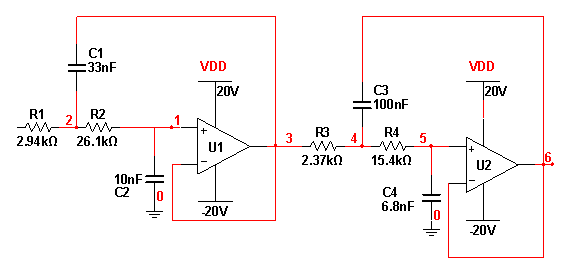 | Figure 1. Fourth order Butterworth Anti-Aliasing Filter |
 The nominal component values of the circuit are R1=2.94 KΩ, R2=26.1KΩ, R3=2.37KΩ, R4=15.4KΩ, C1=33nF, C2=10nF, C3=100nF and C4=6.8nF. The break points of the network are at the corner frequencies 1000.16Hz and 1010.26Hz. The test frequencies chosen are fT={ 750Hz (f1), 800Hz (f2), 900Hz (f3), 950Hz (f4), 1000Hz (f5), 1005 Hz (f6),1010 Hz (f7) and 1200 Hz (f8) }.The illustration of the algorithm has been done taking only hard faults into consideration. Similarly the soft faults can also be considered. The faults considered are F0=Nominal or Fault free, F1=R1 short, F2=R2 Short, F3=R3 Short, F4=R4Short, F5=C1 open, F6= C2 open, F7=C3 Open and F8=C4 Open. The voltage gain is measured at different faults and frequencies. The fault signatures are tabulated resulting in the fault dictionary shown in Table 1.
The nominal component values of the circuit are R1=2.94 KΩ, R2=26.1KΩ, R3=2.37KΩ, R4=15.4KΩ, C1=33nF, C2=10nF, C3=100nF and C4=6.8nF. The break points of the network are at the corner frequencies 1000.16Hz and 1010.26Hz. The test frequencies chosen are fT={ 750Hz (f1), 800Hz (f2), 900Hz (f3), 950Hz (f4), 1000Hz (f5), 1005 Hz (f6),1010 Hz (f7) and 1200 Hz (f8) }.The illustration of the algorithm has been done taking only hard faults into consideration. Similarly the soft faults can also be considered. The faults considered are F0=Nominal or Fault free, F1=R1 short, F2=R2 Short, F3=R3 Short, F4=R4Short, F5=C1 open, F6= C2 open, F7=C3 Open and F8=C4 Open. The voltage gain is measured at different faults and frequencies. The fault signatures are tabulated resulting in the fault dictionary shown in Table 1.
|
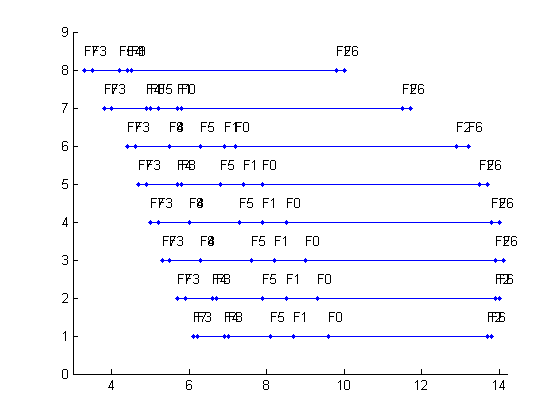 | Figure 2. Ambiguity Sets |
| |||||||||||||||||||||||||||||||||||||||||||||||||||||||||||||||||||||||||||||||||||||||||||||||||||||||||||||||
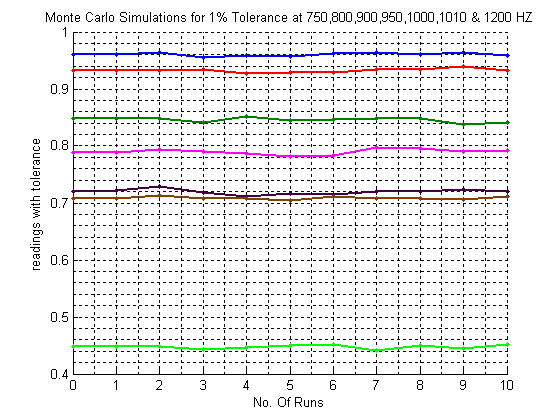 | Figure 3. Monte Carlo Simulations for 1% Tolerance |
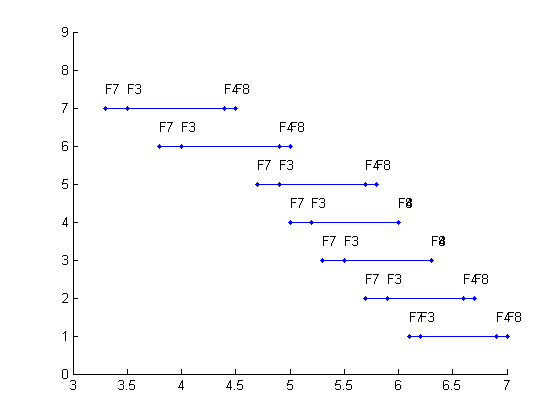 | Figure 4. Sub-Ambiguity Sets |
| |||||||||||||||||||||||||||||||||||||||||||||||
7. Conclusions
- In this paper various methods are proposed which not only reduce the number of test frequencies but also reduce the size of the fault dictionary. Monte Carlo analysis has been used to construct the sub-ambiguity table. For this the practical tolerances of the components are considered thus diagnosing more number of faults.
 Abstract
Abstract Reference
Reference Full-Text PDF
Full-Text PDF Full-text HTML
Full-text HTML